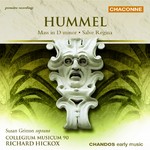
Mass in D minor / Salve Regina
 $28.00
Out of Stock
$28.00
Out of Stock2-6 weeks add to cart
HUMMEL
Mass in D minor / Salve Regina
Susan Gritton / Pamela Helen Stephen / Mark Padmore / Stephen Varcoe / Collegium Musicum 90 / Richard Hickox (conductor)
[ Chandos / CD ]
Release Date: Saturday 1 October 2005
This item is currently out of stock. We expect to be able to supply it to you within 2 - 6 weeks from when you place your order.
'But Susan Gritton sings it [Salve Regina] with gusto, while she and the other soloists form a well-blended quartet in the Mass, whose performance under Hickox is confident and shapely, as well delivered in warm lucid sound.'
BBC Music Magazine
The Mass in D minor is the second of Hummel's masses, dated August 1805, which suggests that it was prepared for the annual name-day celebrations of Princess Marie Esterházy, as was the custom. Hummel seemed determined to demonstrate that, like the revered Esterházy Kapellmeister Haydn, he too could compose a mass that combined individuality with the comforting sense of a continuing musical tradition. But Hummel's point of departure is not Haydn, it is Mozart, specifically the very atmospheric opening of the D minor piano concerto (K466), a work well known to Hummel the virtuoso pianist. At nearly ten minutes this Kyrie is one of the longest opening movements of a mass in the classical Viennese tradition, as expansive in its progress as Haydn's Nelson Kyrie had been focused. Striking opening gestures are a feature of several other movements in the mass, although the beginning of the Credo is deliberately tame, a ruminative oboe solo over a simple accompaniment before the bass voices of the chorus enter. Hummel's mass is scored for full orchestra (including clarinets) plus four soloists and chorus. The main function of the soloists, as in Haydn's masses, is to act as representatives of the chorus, four individuals who then retreat into the choral sound.
The Salve Regina in B flat was composed five years later. In May 1809 Joseph Haydn had died and it is not impossible that this work was composed for a commemorative service. Hummel would have witnessed Haydn's unquestioning Catholic belief; setting this text in his memory, rather than a mass, would have been an appropriately individual tribute. In Hummel's setting the vocal forces, solo soprano and chorus, are typical, but this soprano's natural habitat is the opera house not the church, a reminder that the Esterházy court had a flourishing operatic tradition to which Hummel himself contributed. The extravagance of the soprano line is complemented by an unusually elaborate role for the chorus.


